During my 15 minutes of focus, the first thing that caught my attention was the weather. The temperature was chilly but comfortable; I didn’t feel like I was freezing or I needed a jacket. Altostratus clouds covered the sky, forming a blockade against the sun’s warmth and light. They also released a light misty rain from the south upon my sit-spot and I. Nothing that made me want to get up and leave though it was quite refreshing. It brought in an earthy, fresh grass smell that came across my nostrils, like the one you smell before a big storm; it was calming. It was still pretty early in the day, so I heard the chirping of birds and the calls of the crows as they flew over my head. My attention quickly shifted to a squirrel who was running along the top of the fence. I watched in amazement; the balance that squirrel possesses is beyond me. The squirrel ran across the fence effortlessly and with so much grace. The squirrel then leaped onto a tree and dashed up the side of it, disappearing within its leaves.
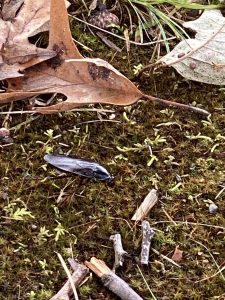
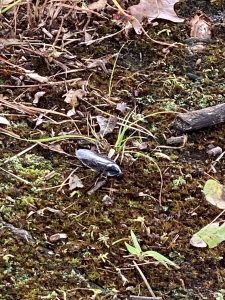
I also had focused on a waterbug who was taking a stroll on the trunk of my observation tree. I looked away for a few seconds when I looked back down at the ground the waterbug was making its way towards me. It was pretty big, but I’m guessing that’s the size of an average waterbug. Sadly, it just ended up scrolling right past me (maybe headed to a water source), but I was able to snap a quick picture. If I had to pick anything to learn more about, it would be about squirrels and how they have such excellent balance and precision while running and jumping.
During my auditory tuning, I heard the sound of leaves dancing in the wind and their rustling sound as they pushed up against one another. Such a beautiful sound, but of course, that was cut short by a loudmouth human. It was a deep raspy voice coming from the north from that same direction came a banging. This banging sounded like a ball hitting the road or a hammer hitting wood. I just had to do my best to tune the voice and banging out. When I finally did, I heard the birds chirping their lovely melody again. When doing the auditory tuning, it made me focus even harder on my sit-spot. It allowed me to visualize what I was hearing, making it an altogether different experience than just viewing the sit-spot.
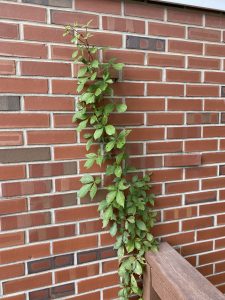
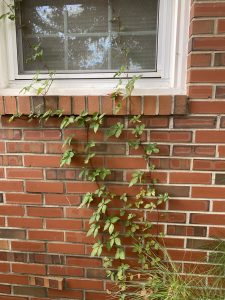
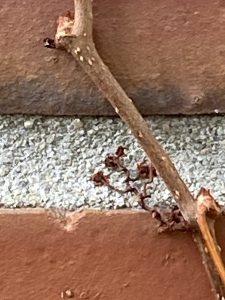
My first identified species was a Virginia Creeper (Parthenocissus quinquefolia) it’s taxonomy is
Plants (Kingdom Plantae)
Vascular Plants (Phylum Tracheophyta)
Flowering Plants (Subphylum Angiospermae)
Dicots (class Magnoliopsida)
Grapes (Order Vitales)
Grape Family (Family Vitales)
Virginia Creeper Parthenocissus quinquefolia)
(commonly related to grapevines). Some interesting facts that I learned about the Virginia creeper are that they can grow up to 20 meters high, doing this at a pretty fast rate. They are a climbing plant, so you’ll most likely find them growing on the sides of buildings, houses, trees, etc. This plant also produces fruit in the early summer blue blackberries. These berries are not a safe snack for humans to munch on; these berries contain tiny crystals called oxalate crystals, that when ingested cause a burning sensation in the mouth, stomach pain, vomiting, and diarrhea.
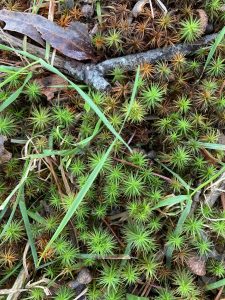
My second identified species was hair-cap mosses (polytrichum commune) it’s taxonomy is
Plants (Kingdom Plantae)
Mosses (Phylum Bryophyta)
Class polytrichopsida
Order polytrichales
Aloe-Mosses (Family Ploytrichaceae)
Haircap Mosses (Genus Polytrichum).
This moss is located in peat bogs, old fields, and areas with high soil acidity, predominantly north of the equator. This moss also browns with age; I remember trying to figure out why some moss was green and others were brown. I thought it had to do with water availability, but it is actually due to the aging of the moss. (quite interesting!)
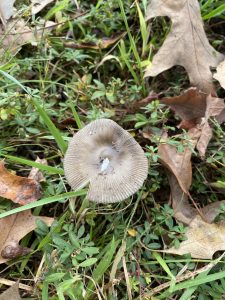
My third identified species was Amanita Subg. Amanitina Mushrooms (Subgenus Amanitina) it’s Taxonomy is
Fungi Including Lichens (Kingdom Fungi)
Basidiomycete Fungi (Phylum Basidiomycota)
Higher Basidiomycetes (Subphylum Agaricomycotina)
Class Agaricomycetes
Subclass Agaricomycetidae
Common Gilled Mushrooms and Allies (Order Agaricales)
Suborder Pluteineae
Amanita Mushrooms and Allies (Family Amanitaceae)
Amanita Mushrooms (Genus Amanita). This mushroom genus contains some of the most toxic mushrooms found in the world. While at the same time having some of the world’s well-regarded edible mushrooms. These mushrooms contain amatoxins, a toxin that is known for causing failure of the liver, which ultimately leads to death.
Overall all I had a pretty good sit-spot experience, there were a couple of distractions, but overall, I remained pretty focused. One thing that I would like to mention that I didn’t get the chance to; would be a root from the cherry oak bark that was above ground. A section of this layered root was glowing in a red-orange color (almost like an infected wound) and from this area leaked sap that resembled pus. I was shocked but very intrigued and invested. I was surprised because this was my first time seeing something like this before. I would differently want to learn more about it and if anyone knows anything about it, I would love it if you could share that information.

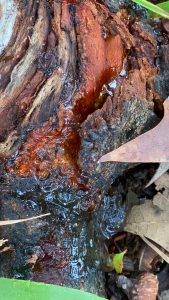
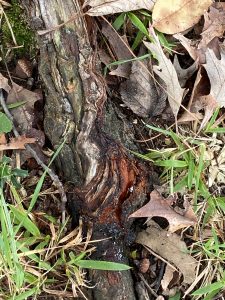
You are right when you say had a good sit-spot experience because that is indeed what it is. Sorry your auditory tuning was interrupted by a ‘loudmouth human’.
Thanks for making me see and get to know about water-bugs for the first time in my life.
I’m happy I don’t eat berries so I will never be a victim of the harmful ones that could be produced by Virginia Creepers. I also don’t like mushrooms, so I may never suffer the effect of toxic Amanita.
About the root dripping sap, I read that warmer weather produces pressure within trees which causes tree sap to flow from the tree through openings produced from cracks or injury.
This sap is a defense mechanism against pests and disease. It also helps in damage repair. Just like the scenario of platelets forming blood clots in order to heal a wound faster.
Hi Zoe, I loved your pictures, especially of the water bug. I also really liked all your details about the things you identified!
I could be wrong, but I do believe that the leaves of the Virginia Creeper can cause skin irritation. The leaves when damage can act like a fiberglass and cause itching and redness. It’s been a while since I have read up on them though!
Great blog Zoe – and I love the comments it inspired!!!